
The San Juan Mountains (From San Luis Valley)
To begin, I would like to mention that the San Juan mountain range was created due to volcanic activity that took place around 30 million years ago. It is believed that this mountain range’s life began when the eruption of La Garita Caldera occurred. This eruption left a massive caldera. After years of volcanic activity (lava flows and tuffs) the San Juan Mountains were born. The type of volcano that erupted to create the San Juan Mountains can be referred to as a strato-volcano. These volcanoes are extremely explosive due to their composition. These volcanoes are unlike cinder cone, and shield volcanoes in that they often have more than one volcanic vent, and the mountains they create are often steep and jagged. Forms that are associated with the process of strato-volcanoes erupting are, lava flows (which can be found today in the San Luis Valley), Nuee Ardente (Hot, avalanche-like, cloud of ash), and different pyroclastics (such as bombs and tephra which can still be found in the San Luis Valley). Although the volcanoes have not erupted for thousands of years, there is evidence of volcanic activity that can still be found in the San Luis Valley. This evidence comes in the form of geothermal energy created by many hot springs located in the area.

This image shows faulting in the San Luis Valley (Alamosa Horst and Monte Vista/Baca Grabens)
The San Luis Valley was created through a diverging plate boundary also known as a rift zone. 35 million years ago the Rio Grande Rift became active. This plate divergence runs from Leadville, Colorado to El Paso, Texas. As the rift moved, it created two low areas called the Monte Vista Graben (West) and the Baca Graben (East). A raised area, central to these Grabens is called the Alamosa Horst. Also due to this rift zone, the Sangre de Christo Mountain Range was uplifted, as it makes up the eastern boundary of the Rio Grande Rift. This rift zone is only subject to minor tremors and is not expected to make large movements.

Aerial View of some Alluvial Fans
An interesting fact about the San Luis Valley I came upon was that if the Valley was excavated, the bedrock underneath it would be located about four miles below sea level. The reason the valley is not this deep today is because as the Sangre De Christo and San Juan Mountains eroded and filled the valley with sediment. This is an example of Alluvial fans seeing as how many rivers (ancient Arkansas and Rio Grande) and streams flow out of the mountains and into the San Luis Valley carrying sediments with them.
I love the Great Sand Dunes, I have taken many trips there where I have camped, golfed, and ridden dirt bikes and fourwheelers. I have always found myself finding sand in odd areas in my clothing or vehicles for weeks after a trip. I think that San Luis Valley and Sangre De Christo area very beatiful and one of my favorite places to visit. I found the part about the bedrock underneath the Valley being nearly four miles below sea leve very interesting. Does this erosion and filling have anything to do with the Western Interior Seaway and the creation of the rockies? Or was the erosion caused by a different event becasue the formation of the Sangre De Christ's newer? The formation about the mountains is very intersting, but I personaly find the formation of the Dunes to be incredible. I love the fact that they are ever changing and actually growing a bit from the continued process of sand being blown up from the flood plain and landing at the dunes. The amount of water that rests in that area is amazing, even with all of the wind you only have to dig a couple of inches to find wet sand. You picked a great location and I can't wait to read more about the formation, climate, and geography of the Great Sand Dunes.
ReplyDeleteComment By:
Joel Rifkin
I love the Sand Dunes and generally find my way to Alamosa once or twice a year. I thought it was very interesting that the bedrock in the San Luis Valley is so deep. It's a good example of the effect even just sediment can have on a landscape. I did not know that the San Juan Mountains were created by a volcano, and it was neat to learn that. I am a bit curious as to whether or not scientists believe there is going to be volcanic activity in the future.
ReplyDeleteSusanna Diller